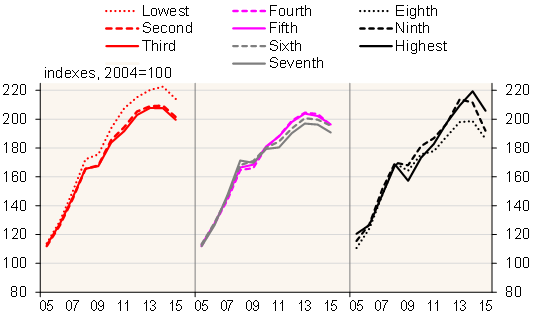BOFIT Weekly Review 19/2016
Russia’s recession has slightly reduced income differences
Rosstat reports a narrowing of income disparity a bit similar to that seen in the 2009 recession. Nominal incomes in 2015 per family member rose in the three highest income deciles by 5−8 % and in the other deciles by about 12 % (a decile contains 10 % of the population). Incomes have risen fastest in recent years in high-income groups, but over the past ten years low-income groups have seen the overall fastest rise. This was due, in particular, to large hikes in pensions and public sector wages in certain earlier years.
A decline of the Gini index, an overall measure of income disparity, shows that income disparity in Russia has slightly shrunk over the past eight years. In 2007−2010, Russia’s Gini index reading exceeded 42 and in 2015 it was 41.2, which was still higher than in the early 2000s (under 40). The figure roughly matches the US. It is lower than in countries showing very high income disparity, e.g. Brazil (about 53), but considerably higher than in the EU countries.
Russian real household incomes have in the past decade increased slightly more in lowest and highest income deciles than in middle deciles. The relative status of lower deciles, however, has not improved as much as nominal incomes suggest. Lower deciles spend much more on food, and food prices have risen faster than prices of non-food goods.
Change in real household incomes by income decile

Sources: Rosstat and BOFIT.